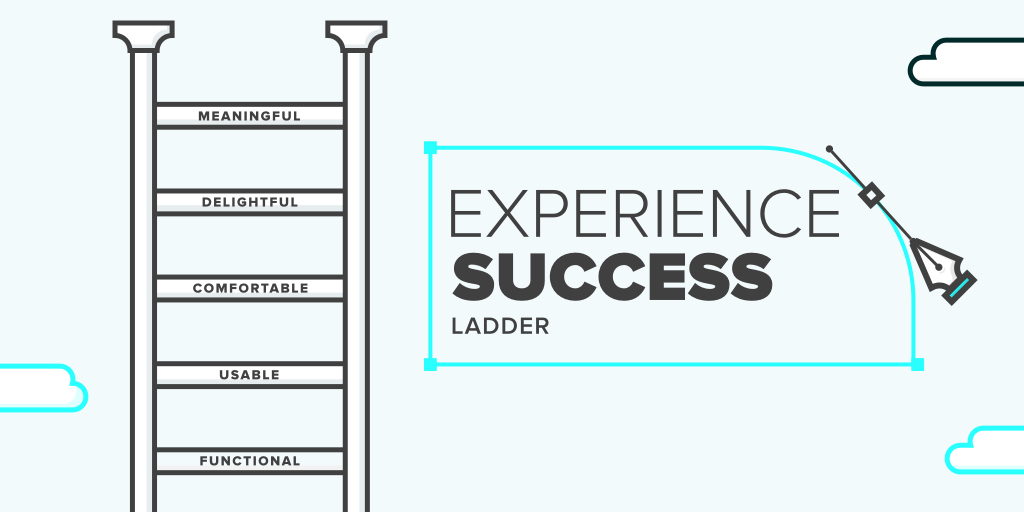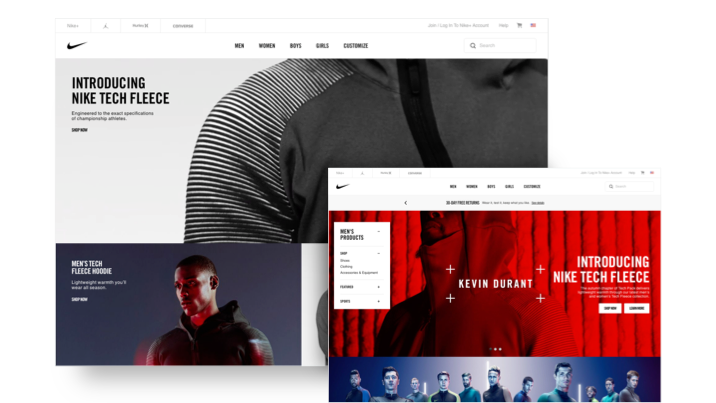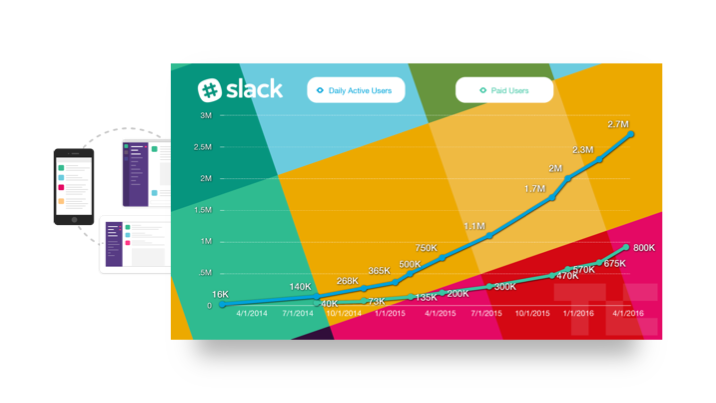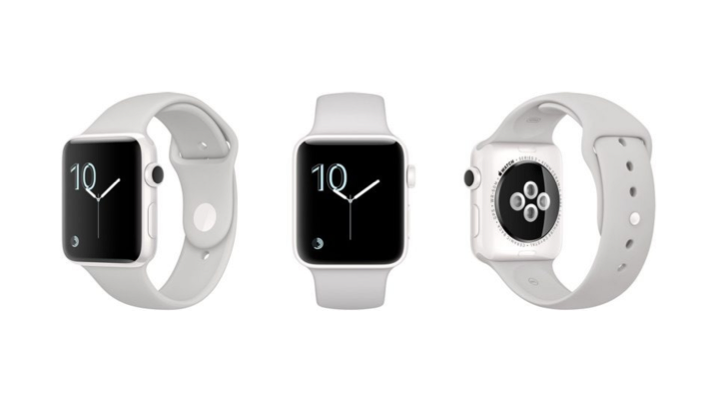The Experience Success Ladder: How to Create a Meaningful Experience

Close your eyes, and think back to the first road trip you took as a kid. Your family packed the car to the brim, grabbed enough snacks to feed an army, and set off on your journey. While Dad was driving, Mom sifted through her stack of maps to find the right one, often resulting in missed exits, wrong turns, and screamed obscenities.
Little did Mom and Dad know that a little technology company would come along years later and change road trips forever with Google Maps.
Did paper maps do the job? Absolutely. But were they intuitive, delightful, and life-changing? Probably not. A product ripe for innovation!
To take products and services from good to great, we have to go beyond functional requirements and deliver usable, comfortable experiences that not only delights users, but also affect their lives on a deeper level.
Over the past 10 years, Google Maps has completely transformed the way we travel. It’s saved millions of hours in driving time, helped avoid millions of accidents caused by drivers reading maps, and become the new standard for navigation.
That’s the power of an amazing product or service experience.
Good experiences allow users to accomplish basic tasks. The problem is that consumers have hundreds – sometimes thousands – of options for ways they can complete those tasks, so “good” will only get you so far. To take products and services from good to great, we have to go beyond functional requirements and deliver usable, comfortable experiences that not only delight users, but also affect their lives on a deeper level.
The Secret Pattern Behind Every Successful Experience
Once digital navigation was introduced, plenty of other companies got in on the action. Despite the competition, Google Maps has remained the gold standard. But why? Why have companies like MapQuest and even the almighty Apple failed while Google survived? What did Larry Page and Sergey Brin do that Barry Glick and Tim Cook didn’t?
They used an intentional, user-driven design process that resulted in meaningful experiences.
First, Page and Brin knew they had to get the basics right. Google Maps had to work well and make it easier to get from point A to point B. Once the functionality and simplicity were in place, they focused on adding moments of delight: turn-by-turn directions, multiple transportation options, Night Mode, and more.
Meanwhile, the competition was still stuck on the fundamentals. MapQuest was eclipsed by more usable apps, and Apple Maps was so unreliable that most people abandoned it quickly.
The result? Market dominance by Google Maps. Despite Apple Maps being the natural choice for iPhone users, over 70% still favor using Google Maps. (Even worse, only 9% of iPhone users say they prefer Apple Maps. When your own customers are choosing a competitor, you know there’s a problem!)
An intentional, user-driven design process results in meaningful experiences.
Although Page and Brin may not have known it, they were moving Google Maps up the Experience Success Ladder. They started at the purely functional level (“Yes, this helped me get directions.”) and slowly worked their way up to delivering a deeply meaningful experience (“Wow, this totally changed the way I travel!”).
The Experience Success Ladder: 5 Steps to Creating Meaningful Experiences
The Experience Success Ladder serves as a benchmark for assessing the value your product or service provides now, as well as goals to aspire to in the future. Each rung represents a higher state of emotional satisfaction and meaningful value. By moving up from one rung to the next, you’re not only better meeting your users’ needs, but also increasing your company’s likelihood of success.
The Experience Success Ladder serves as a benchmark for assessing the value your product or service provides now, plus ways to take it to the next level.
Experience Success Ladder Rung #1: Functional
Plenty of experiences are “functional” and get the job done. However, just because you can complete a task doesn’t mean the product or service is usable.
Think of the old Honeywell thermostats. They may have effectively controlled the temperature of your home, but they practically required an engineering degree to understand the complex control panel if you wanted to change a setting or go away on vacation.
Settling for “functional” doesn’t just impact usability — it can have deadly consequences. For instance, airbags were developed to save lives in car crashes. They may accomplish that goal for some use cases, but there’s a fatal flaw: Airbags were designed by male engineers for the average male driver.
When an airbag went off, it struck most men in the upper chest and cushioned their impact. However, it hit many women in the chin first, which led to serious injuries and countless deaths. A study of actual crashes by the University of Virginia’s Center for Applied Biomechanics found that women wearing seat belts were 47% more likely to be seriously injured than males in similar accidents.
Instead of being designed based on user needs, functional experiences are engineering- or development-driven, and often heavily influenced by internal preferences and politics.
Therein lies the main reason that products like the Honeywell thermostat and airbags had challenges moving beyond the “functional” rung of the Experience Success Ladder. Instead of being designed based on user needs, they were engineering- or development-driven, and often heavily influenced by internal preferences and politics.
Like a basketball team that’s full of individual winners but can’t make the pass or get easy shots, functional experiences have tons of features or elements that technically work, but their users still can’t accomplish their tasks and often run into unexpected consequences. At a minimum, this leads to several problems:
- Users feel lost and discouraged, resulting in dissatisfaction and abandonment (along with more serious side effects, like we saw with airbags)
- Companies waste time and budget training their employees to use the tools they need to do their job
- Employees lose time and fail to meet their objectives because they can’t complete their tasks efficiently or at all
- Companies lose out on opportunities to serve their customers better because employees are stuck trying to just get the basics to work
Experience Success Ladder Rung #2: Usable
Overcoming usability issues and climbing to the next rung of the Experience Success Ladder requires taking a step back and identifying ways to make your product or service more intuitive for users, not for designers or developers.
Banking apps are a great example of products that are functional and usable, but not quite comfortable or intuitive. They may help customers complete basic tasks, like checking their balance and making payments, but the features that users need most are often buried behind information the bank wants to promote, like credit card applications and product promotions.
Usable products and experiences:
- Have some solid design patterns, but they aren’t baked into every part of the workflow
- Are often designed for internal teams and stakeholders, not end users
- May allow users to accomplish tasks, but cause frustration because certain features and information aren’t well organized or are hidden from view
Experience Success Ladder Rung #3: Comfortable
Experiences that are functional and usable might get decent Net Promoter Scores (NPS), make enough money to survive for a while, and attract a small fan base. But unless the product or service is comfortable, it doesn’t stand much of a chance of greater, long-term success.
Comfortable experiences are intuitive and familiar. They just “feel right.” Their sense of flow makes it easy for users to move from one task to another and seamlessly accomplish their goal. Their designers have gotten the experience to this point by having a “Design Success = User Success” mindset, doing usability research, and making every decision based on what would be best for the user’s comfort.
Comfortable experiences are intuitive and familiar. They just “feel right.”
Creating comfort means seeing more than the pure execution of a task. It means seeing where users slow down and think more, where bits of friction come into play, and smoothing those moments out to create intuitive, enjoyable interactions.
Nike has mastered the art of creating a comfortable site. It features hundreds of products, but to make it seem more comfortable and less overwhelming, Nike groups everything in a logical way and gives visitors many ways to shop. By designing with the user in mind, they created a site that allows consumers to shop in the way that is most comfortable to them, leading to high satisfaction and sales.
By providing a comfortable experience, your company will start to:
- Receive higher satisfaction scores
- Increase revenue and sales
- Build a loyal base of raving fans
- Become a “go-to” tool for users that saves them time and brainpower
Experience Success Ladder Rung #4: Delightful
Once your product or service moves past being functional, usable, and comfortable, you start getting into the upper echelons of design that take a brilliant mind and deep empathy to achieve.
Delightful experiences go beyond helping users accomplish tasks intuitively. They actually make it fun and desirable. Whether it’s cool animations in apps like Snapchat, a secret menu like In ‘N Out’s, or unlocking exciting super powers in Super Mario Bros, little moments of surprise lead to happiness, connection, and diehard fandom.
Slack has used delight to catapult their product to success. The app uses every opportunity – from onboarding to day-to-day interactions – to make the experience more enjoyable. During onboarding, Slack asks users simple questions about themselves in a conversational UI to automatically build personalized account settings. Then, they offer interesting animations, funny jokes in microcopy, and tons of other features that make the app both helpful and fun to use.
Delightful features don’t just come out of nowhere or from one usability test. They stem from having a deep understanding of your users, having conversations over the life of the product or service, consistently testing and proactively planning ways to make them think, “Wow, you really know me!”
Many critics thought Slack was all hype, but the proof is in the pudding: They’ve gone from a startup to an industry leader valued at over $8 billion in just a few years. Designing to delight creates value.
These delightful features don’t just come out of nowhere or from one usability test. They stem from having a deep understanding of your users, having conversations over the life of the product or service, consistently testing, and proactively planning ways to make them think, “Wow, you really know me!”
Plus, delightful moments can’t be designed when your head is down to crank out the next sprint deliverable. They happen when you have the time and freedom to really get to know your audience and brainstorm ways your experience can make the user’s days just a little bit better.
With a delightful experience, your company begins to reap the benefits of investing so much time and effort into design, leading to:
- A spike in KPIs
- Amazing user feedback
- A cult following
- A passionate legion of fans who will fight to the death for your brand
Why so much passion? Delightful experiences make people’s lives significantly better every time they’re used. Taking it away literally makes the person’s quality of life lower.
Experience Success Ladder Rung #5: Meaningful
Many designers are on the quest to make their users’ lives a little easier and happier, but very few reach “the Holy Grail”: meaning. Meaningful experiences are more than just functional, usable, comfortable, and delightful. They change the user’s life and create long-lasting success for the team who designed them.
For example, the first version of the Apple Watch may have had its limitations, but it also had meaningful features that everyone can appreciate and became a life-changing product. One feature helps you find your phone when you misplace it. You simply swipe up on the watch face and press a ringing phone icon, which will sound a loud, distinctive ping from your phone and save hours of time and stress.
The Apple Watch also has a feature that lightly taps you on the wrist and reminds you to stand each hour. For focused knowledge workers who sit at a desk for most of the day, this simple software reminder can lead to meaningful, long-term health benefits.
Meaningful experiences change the user’s life and create long-lasting success for the team who designed them.
Plus, think of inventions like Tesla. These cars aren’t just another vehicle that gets people from one place to another. They’re fundamentally changing the way people drive and the economy as a whole. Tesla is bringing new meaning the the idea of owning and operating a vehicle.
Elon Musk is one of many visionaries who are using design to change the world. Like Larry Page and Sergey Brin, he has tapped into a problem that he’s passionate about and that users need help solving. Sustainable energy solutions make him excited to get up in the morning, and he channels that excitement into designing products that will leave their mark on history.
There are certain techniques that we can learn and incorporate into our own experiences, like having a strong brand strategy, delightful design, unique voice, and frequent usability testing to drive constant improvement. However, much of Musk’s, Page’s, and Brin’s success also stem from that intangible “X Factor.” This “X Factor” is a combination of crystal-clear brand vision, deep empathy for users, and other soft skills that allow you to find the sweet spot between the two.
The “X Factor” is a combination of crystal-clear brand vision, deep empathy for users, and other soft skills that allow you to find the sweet spot between the two.
Although this rung is difficult to reach, the results of having a meaningful experience pay for the hard work many times over:
- Evangelists who tell everyone to use your product or service
- The highest NPS scores in your category
- Fewer complaints and more forgiveness from customers, due to their affinity for your brand and product
- Strong sales that grow over time and weather economic downturns
Time to Climb
Like Larry Page and Sergey Brin, the biggest success stories of our time are those who are transforming purely functional products and services into delightful experiences that add meaning to our lives. Whether these companies used a ladder, mountain, roadmap, or other metaphor for their process, they knew they could create magic using intentional steps that elevate their brand and provide more value to their users. By maintaining a laser focus on user success every step of the way, they achieved business success that others only dream about.
Want to learn more about how to use the Experience Success Ladder and create products and services that change lives? Watch the replay of my InVision Design Talk webinar, Climbing the Design Success Ladder. Then, check out UX Rings, a survey tool that helps creators measure their experience success.






